
Newsletter of the Shell Club of Sydney
NSW Branch, The Malacological Society of Australasia Limited ACN 067 894 848
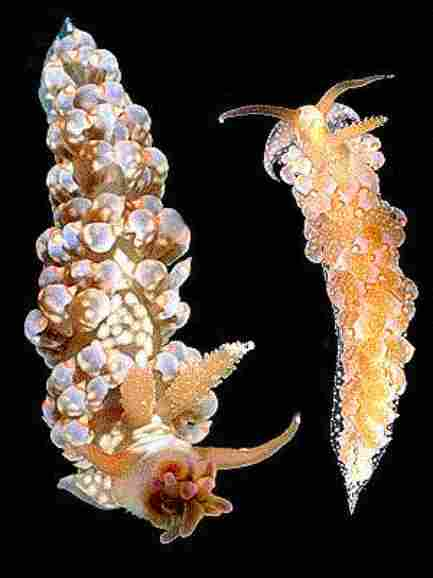
Spurilla australis From NSW
Rudman 1982
Nudibranchs
Your editor has put together the following material as a result of emails sent by Wayne Ellis. The pictures and content are made up from information from Wayne's web pages, and from material in the Australian Museum 'Slug Forum' web pages, administered by Bill Rudman.
The Musem pages provide a good forum for identification of species of
'slugs', and better definition of their range and habitat. Your contributions are most welcome. (Slugs include such things as Bubble Shells). The museum forum pages are at
www.austmus.gov.au/science/division/invert/mal/forum/
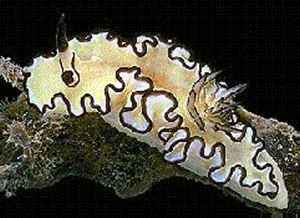
Glossodoris atromarginata
(Cuvier, 1804)
Hello,
My name is Wayne Ellis & I have produced an on-line newsletter dedicated to nudibranchs of the Indo-Pacific, especially the Australasian region. It is produced monthly & can be emailed direct or downloaded from glaskin@ozemail.com.au/~glaskin/annews,pdf
(Adobe Acrobat Reader opens this type of file. )
Contributions are most welcome and your feedback would be appreciated.
If you would like information about nudibranchs please forward your details to.
Wayne Ellis
Glasshouse Kinesiology
P O Box 3
Glasshouse Mountains
Qld 4518
Australia
Ph. 07 5493 0040
Int. 61 7 5493 0040
Mob 015 767 220
glaskin@ozemail.com.au
Wayne Ellis has also created a set of very useful web pages on Nudibranchs.
Start at www.ozemail.com.au/~glaskin/nudis_htm
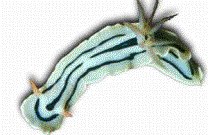
Chromodoris lochi Rudman, 1982
Photograph & copyright Wayne Ellis
The following Paragraphs have been condensed from Wayne's web pages:
Nudibranch means "naked gills" because their gills are on the rear of the back (posterior dorsal) of some species or along the side covered by a protective flap as these species tend to bury into sand or mud. The gills can identify some species. Some species "wave" their gills as they move or feed. Noumea simplex can be identified from the group of small pink chromdorids as it's gills don't wave
rythmically.
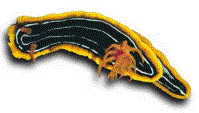
Chromodoris kuiteri Rudman, 1982
Photograph ©right Wayne Ellis
Nudibranchs live in marine environments from Antartica to the tropics. Most spend their adult life on the bottom although two species, Glaucus marginata and Glaucus altanticus float around (pelagic) upside down on the ocean surface. They feed on blue bottles or Portuguese man-of-war's (Physalia physalis) and By-the-wind sailors (Velella velella).
Where do Nudibranchs fit in?
The major mollusc classes are:
1. Limpet-like shells (Class: Monoplacophora)
2. Coat of mails (Class: Amphineura)
3. Tusk shells (Class: Scaphopoda)
4. Clams (Class: Bivalvia),
5. Squid and Octopus (Class: Cephalopoda),
6. Snails (Class: Gastropoda).
The Class Gastrapoda is broken down into three subclasses:
1. Marine snails with shells (subclass: Prosobranchia)
2. Marine slugs (subclass: Opisthobranchia)
3. Land snails and slugs (subclass: Pulmonata).
Within the Opisthobranch's there are five major orders - each exhibiting a varying degree of reduction or loss of a shell. The most primitive group have well developed shells, in others a shell is present in the young (larval) stage This is lost as they grow (metamorphoses) into adults.
1. Bubble Shells (Cephalaspidea)
2. Sea Hares (Anaspidea)
3. Cell Suckers (Sacoglossa)
4. Side-Gilled Slugs (Notaspidea)
5. Sea Slugs (Nudibranchia)
There are four suborders of Sea Slugs:
1. Doridoidea
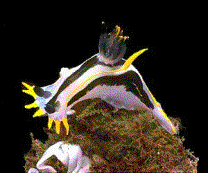
Polycera capensis
Quoy & Gaimard, 1824
(Originally from South Africa.Commonly reported from Sydney to Port Stephens in central New South Wales. Apparently introduced artificially, perhaps on bryozoans fouling the bottom of ships.
PHOTO: Bill Rudman)
The general body shape is circular (ellipsoid) or elongated. The thick fleshy mantle has a skirt extending over the side of the body. Two antennae (rhinophores) often with numerous folds ridges (lamellae) protude from the head (anteriorly). They are used to smell (chemosensors) each other or locate food. Towards the back (posteriorly) are the gills, delicate and flower-like, hence the name nudibranch (naked gills). The anus is found inside the gill plumes. Some species can retract their gills and rhinophores into protective pouches.
Dorids feed on sponges, bryozoa. polychaete worms, ascidians and other opisthobranchs. The digestive gland that is a single mass (holohepatic). They can be brightly coloured and obvious (aposematic) or drab and well camouflaged (cryptic). The red and pink species are especially cryptic below 10 metres as the red has been filtered out of the light spectrum. The colour patterns of particular groups have been studied and a theory is that many species mimic each other. Many dorids have toxins in their mantle glands taken from food source, which they secrete when disturbed. Species without this protection are believed to mimic toxic relatives colour patterns. Another view is that since light cannot penetrate far into water the colours actually assist the animal to blend into the surroundings. Size ranges from 1-30cm.
2. Aeolidoidea
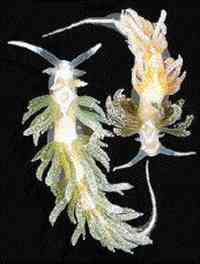
Favorinus japonicus
Baba, 1949
PHOTO: Bill Rudman.
The general body shape is long and slender (elongate), with two feelers on their head, (cephalic tentacles) and sensors (rhinophores) on top (dorsal) and at the front (anterior). They have finger-like extensions (cerata) of their digestive system extending down the back of the animal. Aeolids lack gills and it is believed they absorb oxygen through diffusion. The anal opening varies and can be difficult to observe.
Aeloids may feed on members of the coral family (Cnidaria) which includes sea anemones, corals, soft corals and gorgonians (Alcyonarians), jellyfish, mollusc eggs, goose barnacles and Portuguese man-of-war. These amazing animals can pass the stinging cells (nematocysts) through their digestive system without triggering them off and use them in their own defence. Some species extract algae (symbiotic zooanxanthellae) from their prey and "farm" them. Size ranges from15cm.
3. Dendronotoidea
These nudibranchs resemble aeloids. They have tubular sheaths that surround the rhinophores (rhinophoral sheaths), a mid-lateral anus on the right side, with tufts of gills along the sides of the broad mantle. The head usually has an oral veil (velum). If there is a mantle skirt it is small. Size ranges from 1-30cm. They eat soft corals, anemones or hydroids.
4. Arminoidea
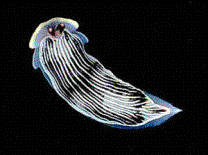
Armina cygnea
(Bergh, 1876)
Photo: Bill Rudman.
There is much diversity in this suborder. The body is flattened and elongate with a mantle which extends into an oral veil. The anus is towards the front (anterior). The rhinophores have vertical plates.. The gills are often along the side under under the mantle. There is a lack of rhinophores sheaths. Coelenterates and bryozoans are the main food source. Size ranges from 1-7cm.

Changes in the taxonomy of the Australian Haliotis
Daniel Geiger is a young scientist at the Department of Biological Sciences, University of Southern California. He is considered to be the world expert on Haliotis and is working on a world-wide classification of the family. He has recently published a paper entitled Recent Genera and species of the family Haliotidae Rafinesque, 1815 (Gastropoda: Vetigastropoda) in the Nautilus vol. 111, p. 85 - 116. He was so kind to send me a copy.
This paper is definitely not a definitive study of the family, but an overview of current taxa, and the results of Dan's examinations of the type material.
There are 17 generic names in the Haliotidae. These are either used as subgenus of the main genus, Haliotis, or as separate genera.. All the described genera are based on shell characters. Of all approximately 200 species names only 80 have been assigned to a genus other than Haliotis, of these 80 names, 22 have been assigned to at least one other genus as well. To add to the confusion, the type species of Haliotis,
H. asinina, is not really a very typical Haliotid at all. The general consensus is not to use the other generic names, although this may be warranted in the future only after detailed studies of the relationships of all species.
The paper also shows that the number of open holes is not a diagnostic feature for species at all, as some books will let you believe. Rather, it is a product of environment and age of the shell. Freaks, with many open holes, or no open holes, are quite common and species descriptions based on these have no validity.
Dan also notes that Haliotis hybridise quite readily, and in Australia, two hybrids,
H. laevigata x H. roei and
H. hargravesi x H. brazieri, are known.
There are about 200 species names available in the Haliotidae. Of these, Dan considers 55 to be valid species, with a further 10 subspecies. He makes a few statements regarding the Australian species:
1. I guess we already knew, although nobody had officially said so, that
H. ethologus Iredale, 1927 is a synonym of H. hargravesi
Cox, 1869 and H. melculus Iredale, 1927 is a synonym of
H. brazieri Angas, 1867. At least now somebody has put it in print.
2. H. conicopora from WA is probably a subspecies of H. rubra
3. H. emmae is a subspecies of H. scalaris
4. H. crebrisculpta: a difficult case. What has been called crebrisculpta in Australia may be either
H. clathrata Reeve, 1846, or H. dissona Iredale, 1929, a name resurrected by Dan.
H. dissona is restricted to central Queensland (and New Caledonia and Tonga), and is a rather smooth shell, with deep spiral grooves.
H. clathrata is widely spread in the Indo-Pacific and is presumably the shell figured by Wilson in Australian Marine Shells Vol. 1.
The true H. crebrisculpta cannot be found in Australia.
A complete listing of the Australian Haliotis according to Geiger:
Indo-Pacific:
asinina Linnaeus, 1758
brazieri Angas, 1869
= melculus Iredale, 1927
clathrata Reeve, 1846
= crebrisculpta of authors
dissona Iredale, 1929
hargravesi Cox, 1869
= ethologus Iredale, 1927
ovina Gmelin, 1791
planata Sowerby, 1882
varia Linnaeus, 1758
Southern Australia:
coccoradiata Reeve, 1846
cyclobates Péron, 1816
elegans Philippi, 1844
roei Gray, 1826
rubra rubra Leach, 1814
rubra conicopora Péron, 1816
scalaris scalaris Leach, 1814
scalaris emmae Reeve, 1846
semiplicata Menke, 1843
squamata Reeve, 1846
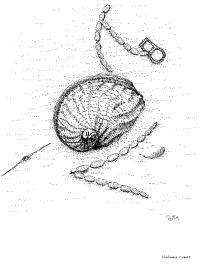
Haliotis rubra
The actual killer cone from 1935
(see sheller Aug98)
Thora Whitehead
I have been following the articles on conotoxins with interest, and thought I would write with the information that the "villain" that killed a young man all those years ago on Hayman Island is present in the Queensland Museum Conus collection, shell and dried animal. (Register number Mo 1689).
The label reads "Dr T.B. Clouston, July 1935, associated with the death of C.H. Garbutt." There is also a microscope slide with spicules, associated with the specimen, as recorded in the register.
The Shell is 85mm in length, faded and with some remnants of periostracum.
Editor: Thora also sent copies of the relevant 1935 clippings and the medical journal reference. These will be available for anyone who is interested, at the Shell club of Sydney
meetings.
Conotoxin reasearch, collecting the shells.
Kevin Lamprell (Condensed from full article in the printed sheller)
The interesting article of Bruce Livett's in the August Sydney Sheller,
resulting from his talk to the Sydney Branch of the MSA on Conus toxins
will bring back some memories to many Queensland Shell Club members who played an important part in the collection of species of Conus for the Centre for Drug Design and Development at the University of Queensland.
A staff member of this University group joined the MSA Brisbane Branch and soon organized members and allied clubs as far north as Cairns to collect cone specimens for this research.
I was approached to obtain some highly toxic specimens of Conus
geographus, striatus, magus etc by the head of the Department who wanted
them returned to Brisbane live so that they could be kept in fish tanks.
Phil Spoor from Townsville generously volunteered himself and his large
boat "Caper", while his brother Doug, Jules Leroy and myself were the
crew.
A week in the Palm Island group of islands living on the "Caper"
produced a large quantity of the desired material which was kept live,
flying back with me to Brisbane where it was collected at the airport by
the departments representative.
Some small financial outlays were met by the Research Group.
Nudibranchs of Port Stevens
Wayne Ellis is compiling a list of Nudibranchs of Port Stephens, NSW.
This preliminary checklist was compiled by Wayne from his own records & photographs 1981-1993. The number of species far exceeds this small representation. Please add your sightings by sending details to glaskin@ozemail.com.au for inclusion. Date, location, size, depth & feeding habits would be appreciated. The current list is on line at:
www.austmus.gov.au/science/division/invert/mal/forum/portslis.htm
Number of species: 45
Polyceridae (Triophidae)
Plocamopherus ceylonicus Kelaart 1858
Plocamopherus imperialis Angas 1864
Plocamopherus tilesi Bergh 1877
Polyceridae (Nembrothinae)
Tambja affinis Eliot 1877
Tambja morosa Bergh 1877
Tambja verconis Basedow & Hedley 1905
Polycera capensis Quoy & Gaimard 1824
Nembrotha rutilans Pruvot-Fol 1931
Goniodorididae
Hopkinsia sp
Okeniidae
Trapania brunnea Rudman 1987
Dorididae
Discodoris c/f concinna (Alder & Hancock 1864)
Discodoris sp (mauve)
Discodoris sp (green)
Trippa intecta (Kelaart 1858)
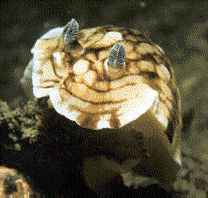
Aphelodoris varia (Abraham 1877)
Neodoris chrysoderma (Angas 1864)
Rostanga sp
Jorunna sp (orange)
Chromodorididae
Chr. "flower petal" (Neville Coleman p.43 Nudibranchs of the South Pacific Vol.1)
Chr. collingwoodi Rudman 1987
Chr. daphne (Angas 1864)
Chr. geometrica Risbec 1928
Chr. loringi (Angas 1864)
Chr. splendida (Angas 1864)
Chr. tasmanesis Bergh 1905
Chr. hunteri Rudman 1983
Chr. woodwardi Rudman 1983
Glossodoris angasi Rudman 1986
G. atromarginata (Cuvier 1804)
Hypselodoris bennetti (Angas 1864)
Ceratosoma brevicaudatum Abraham 1876
Ceratosoma amoena (Cheeseman 1886)
Noumea sulphurea Rudman 1986
Mexichromis mariei (Crosse 1872)
Thorunna speciosus Rudman 1990
Dendrodoridae
Dendrodoris denisoni (Angas 1864)
Flabellinidae
Flabellina rubrolineata (O'Donoghue 1929)
Flabellinia peonicia (Burn 1957)
Facelinidae
Pteraeolidia ianthina (Angas 1864)
Arminidae
Dermatobranchus sp.
Janolidae
Janolus sp
Tritoniidae
Tritonia sp ( feeds on Telesto multiflora soft coral)
Bornellidae
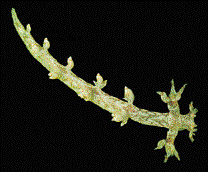
Bornella stellifer (Adams & Reeve 1848).
Glaucidae
Cratena lineata (Eliot 1904)
Phyllodemium poindimiei (Risbec 1928)
Book Review
By Patty Jansen
Bivalves of Australia Vol. 2
By Kevin Lamprell and John Healy
Backhuys Publishers Leiden, March 1998, ISBN 90 73348 92 7, 288 p., 112
plates, 89 in colour, hard cover, 175 x 244 mm.
This book has been long awaited and will be a very valuable addition to the
now impressive array of books on shells from Australian, and Indo-Pacific, waters. Right up until the publication of Bivalves of Australia Volume 1, there was really no shell book that contained a significant number of Australian bivalves at all. We were left fumbling around in the dark, when trying to identify our bivalves. Volume 1 was a very important step in the right direction, but many of us, including myself, joked about all the interesting families being left out, but that is basically what it came down to. The difficult families, including the Mytilidae, Arcidae and Pteriidae needed much more work, especially due to their Indo-Pacific range, and were left out of Volume 1, which contained only 25 families.
To complete the work on the Australian bivalves, Kevin had to travel to the European museums to study type material, and describe new species before this book could be published. And he had to study the complete nightmare of the tiny Australian bivalves, an area that almost everyone has steered well
clear of.
He also had to find a new publisher, and a new co-author for Volume 2 of
Bivalves of Australia. Kevin Lamprell is well-known for his extensive
knowledge on bivalves. He is the author of Spondylus, spiny oyster shells of the world, and Bivalves of Australia vol. 1 (together with Thora
Whitehead) and many scientific articles describing new species of bivalves. John Healy, a senior research fellow from the University of Queensland, co-authored many of these scientific publications with Kevin, and became the co-author of this book.
The result is well worth it, and together with Volume 1, gives a pretty good account of the Australian bivalve species. Seventy-two families are
included in volume 2, which are the remainder of the bivalve families known to occur in Australia, that were not included in Volume 1. The key families covered by this volume are Arcidae (nine plates), many of which have never been photographed, the Mytilidae (ten plates), the Pteriidae (six plates), as well as the Ostreidae and Spondylidae. Quite a few species in these families are of economic importance. Then there are the more unusual families, like the Ungulinidae, Galeommatidae (six pages!), Solenidae, Corbulidae, Teredinidae, Myochmidae and the Clavagellidae. The book also gives a good summary of the current knowledge, or rather, lack thereof, of those pesky Australian micro-bivalves. The Australian freshwater bivalves are also included.
It is a neat and tidy publication, with an abundance of good figures. I
especially like the layout of the book, with the text positioned next to the plates. There are 112 plates, 89 of which in colour. The other ones are
black and white photographs freshwater mussels) or reproductions of original drawings of type specimens (micro-bivalves).
This book is going to prove very useful. When I first looked at it, I
immediately recognised some species from the bottom drawer of my shell
cabinet. These shells had been in there for a long, long time and several
times I had almost thrown them out because I thought they were juveniles of something else, or just out of sheer frustration of not being able to
identify them.
I really cannot say too many bad things about the book, especially about it's content. I still do not like the font the publisher has chosen. I
think it looks cluttered and I especially feel that the absence of proper
headings for the family and genus names makes it very hard to see where a family stops and the next one begins.
I also think the front cover could have been a bit kinder to the eye, but I
guess that is really a matter for personal preference. At least you will be able to see it on your bookshelf from considerable distance. It probably even glows in the dark. But then, that is probably indicative of the
importance of this work for anyone with an interest in Australian and
Indo-Pacific bivalves.
|











